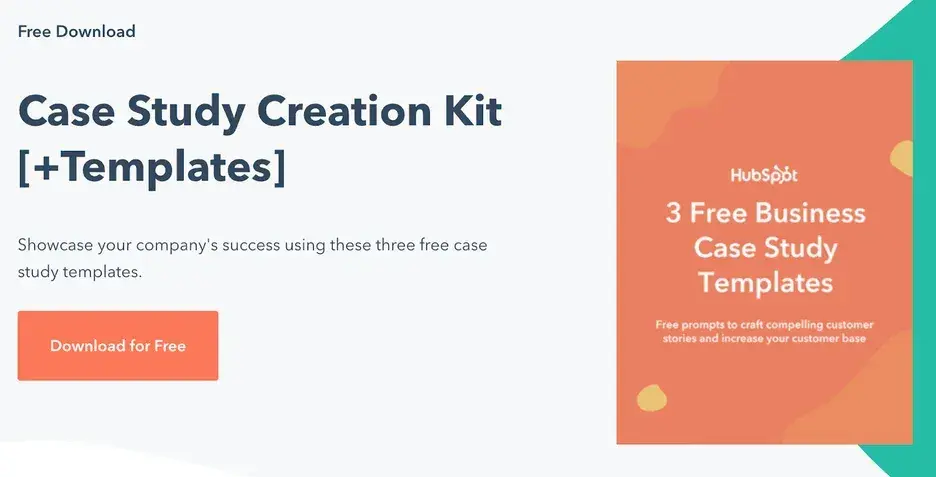I have a confession: I’m a chronic review reader. I start every purchase with a Google search. I rely on content — both from reviewers and from companies themselves — to make my final decision.
So, here’s what I know firsthand: Shoppers are looking for different types of content at different stages of the buyer’s journey.
Here’s an example. I recently decided to automate my LinkedIn thought leadership. To find the right solution, I read listicles about social media management tools.
Once I was acquainted with the market, I looked up product overviews. Then, I watched demos to see how the tools work. When I finally chose Buffer, I had dozens of pieces of content to support my decision.
As a marketer, you need to craft a strategy that supports the different stages of your buyer’s journey. You’ll need material for every step of the content marketing funnel. Below, I’ll share strategies that work — both as a marketer and a consumer.
Let’s dive in.
Table of Contents
What is the content marketing funnel?
The content marketing funnel maps the buyer's journey from initial awareness, through consideration, to the final purchase decision.
Understanding this division — typically top, middle, and bottom — helps you create targeted content that addresses prospects' needs and nurtures leads through each stage of the decision-making process.
Aligning content with each stage of the buyer's journey helps you provide value, build trust, and guide customers toward choosing your product.
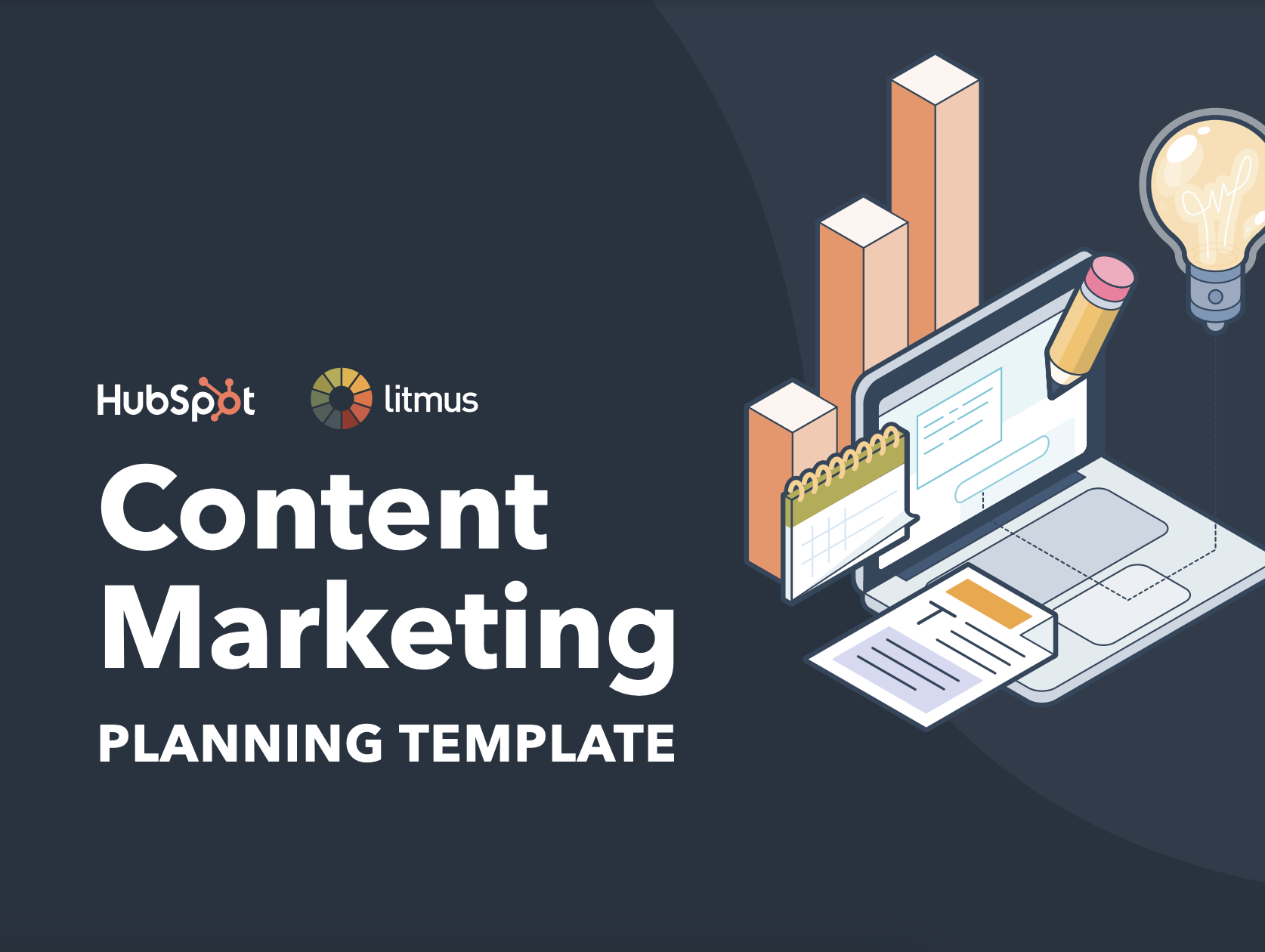
Content Marketing Planning Templates
Plan your content strategically with these handy templates.
- Editorial Calendar Template
- Buyer Persona Templates
- SWOT Analysis Templates
- SMART Goal Template
Download Free
All fields are required.

Levels of the Content Marketing Funnel
As I highlighted in the previous section, you can divide your content marketing funnel into three stages.
In this section, I’ll explain what each of these levels involve and the kind of content you can create, using my own business as an example.
Top of the Funnel (ToFu)
At the top of the funnel, I focus on attracting B2B SaaS decision-makers who are just realizing they have content challenges. My goal is to educate and inform, not to pitch my services directly.
I create content like:
- Blog posts addressing common B2B SaaS content struggles
- Infographics showcasing content marketing ROI statistics
- LinkedIn posts sharing quick content strategy tips
- Short videos explaining content trends in SaaS
With these, I hope to attract potential clients and showcase my expertise in the B2B SaaS space.
Middle of the Funnel (MoFu)
In the middle of the funnel, I target B2B SaaS prospects actively seeking content solutions. They're comparing options, so I position my services as the ideal choice.
I develop content such as:
- In-depth guides on creating effective SaaS content strategies
- Case studies highlighting my success with other B2B SaaS clients
- Detailed posts exploring specific content challenges in SaaS
- Comparison charts showing how my approach differs from in-house teams
This content helps prospects evaluate my services and builds trust in my specialized knowledge.
Bottom of the Funnel (BoFu)
At the bottom of the funnel, I focus on B2B SaaS decision-makers ready to choose a content strategist. I aim to overcome any final objections and encourage them to reach out.
I offer content like:
- Free content audits or strategy consultations
- Testimonials from satisfied B2B SaaS clients
- Detailed breakdowns of my content strategy process
- ROI projections based on previous client results
The goal of this content is to convert prospects into clients by offering the last piece of information or reassurance they need to choose my services.
Understanding the Buyer’s Journey in Marketing
Throughout my years as a content strategist for B2B SaaS companies, I‘ve personally discovered the buyer’s journey is rarely a straight path.
With the exception of impulse software purchases (which are rare in B2B), most decision-makers begin in an “unaware stage.” They typically fit the demographics of an ideal client — what I call a buyer persona — but they‘re unaware of the SaaS solution or don’t yet realize they need it.
A triggering event often changes their situation or highlights a pain point that needs solving. This is what kicks off their buyer's journey.
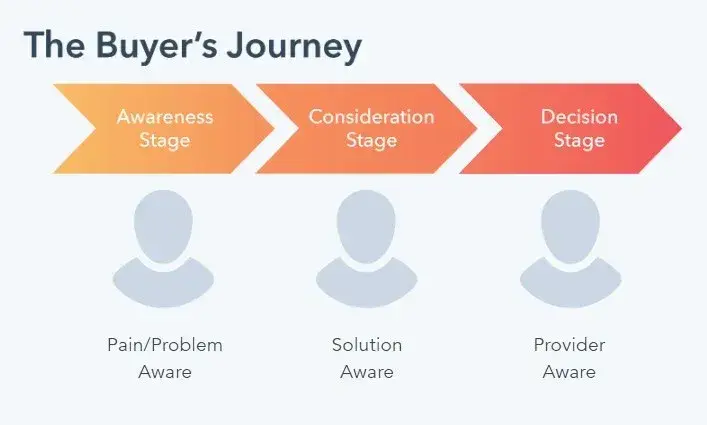
Let me share an example I've used with clients: Imagine a growing startup realizes its project management is becoming chaotic. These companies rarely decide to purchase a SaaS project management tool immediately.
Instead, they often turn to the internet to learn more and make decisions as they progress through the following stages. My job is to assist them in that decision-making process through strategic content.
Awareness Stage
In the awareness stage, B2B buyers are experiencing a problem or pain point, and their goal is to alleviate it. They're typically looking for informational resources to more clearly understand, frame, and give a name to their problem.
A common search query a prospect might begin with is: “How to improve team productivity?” At this stage, they‘re not yet thinking about specific SaaS solutions; it’s much too early for that.
Instead, they‘re looking to contextualize their problem first. As a B2B SaaS content strategist, I’ve discovered that showing up in search engine results, even in these early stages, is crucial to establishing authority and gaining the trust of buyers starting the journey.
Consideration Stage
Moving to the consideration stage, I‘ve observed that B2B buyers have usually clearly defined and named their problem.
They’re now committed to researching and understanding all available approaches and methods to solving their defined problem or opportunity. In other words, I've seen how they start considering potential SaaS solutions.
From my work, I know that a typical search inquiry a prospect would make at this stage might be: “Project management software vs. traditional methods?” In the consideration stage, the prospect isn't yet ready to buy, but they are deciding on the potential solution for them.
My strategy here is to consider indirect competitors and educate prospects on the pros and cons of various SaaS options.
Decision Stage
Once they've progressed to the decision stage, B2B buyers have typically decided on their solution strategy, method, or approach.
Their goal now is to compile a list of available SaaS vendors, make a short list, and ultimately make a final purchase decision.
Prospects at this stage make search inquiries like: “Asana vs. Trello vs. Jira.” At this point, they‘re ready to invest in a solution.
They’ll likely go with a SaaS provider they like, know, and trust so long as that provider can meet their specific business needs.

150+ Free Content Creation Templates
Access ebook, blog post, CTA, case study, and more content templates.
- Ebook Templates
- CTA Templates
- Blog Post Templates
- And more!
Download Free
All fields are required.

Why Creating Content for the Buyer's Journey Is Important
As in all marketing disciplines, it’s essential to understand your audience: how they think, the answers they seek, and the path they tend to take to find a solution.
From that research, you can begin crafting a documented content strategy that maps your content to the various stages of the buyer's journey.
When you don‘t completely understand your audience, it creates a disconnect between your business and your potential customers.
For content marketers like me, this usually means you’re putting out content your readers don't really relate to, which can cause you to lose them.
To avoid this, you‘ll have to consider the stage they’re at in their journey, how to meet them there, and the best channels to put the content in front of them. The internet has made it easier for marketers (and salespeople) to engage customers at the various stages of their journey using content marketing.
That’s one of the main reasons why 14% of marketers consider content marketing the marketing channel with the highest return on investment (ROI).
HubSpot's marketing platform offers powerful automation tools that can help streamline this process. I love how you can use the platform to create personalized content experiences, see how users engage at each stage of their buying process, and send tailored content when users need it.
Creating the right content at the right time can, however, be a challenge.
Building a content strategy starts with identifying the types of content you’ll need to reach your audience according to their progression through the buyer’s journey, and we’ll guide you through it in terms of both the marketing flywheel.
Creating Content for Each Stage of the Buyer's Journey
Once you have an idea of your buyer persona and how prospects move closer to purchase, you can begin creating content for your buyer at different stages and tailor that content per channel.
Doing so can help you map your content to the relevant stages of the buyer’s journey to make a marketing funnel.
Your journey may look very different depending on your industry, business model, product, pricing, and audience.
Some B2C customers, for example, spend very little time in the middle of the buyer’s journey compared to B2B customers, who require far more nurturing, engagement, and relationship development before a purchase is made.
A $50 pair of sneakers, for instance, requires a lot less hand-holding when it comes to making purchase decisions than a $10,000 business software investment.
Content Ideas for Each Stage of the Buyer's Journey
Because audiences can vary widely based on industry and intent, persona research is of the utmost importance.
By understanding their unique process for awareness and evaluation, you can create a truly effective content marketing funnel and strategy packed with custom content that best supports their journey toward making a purchase.
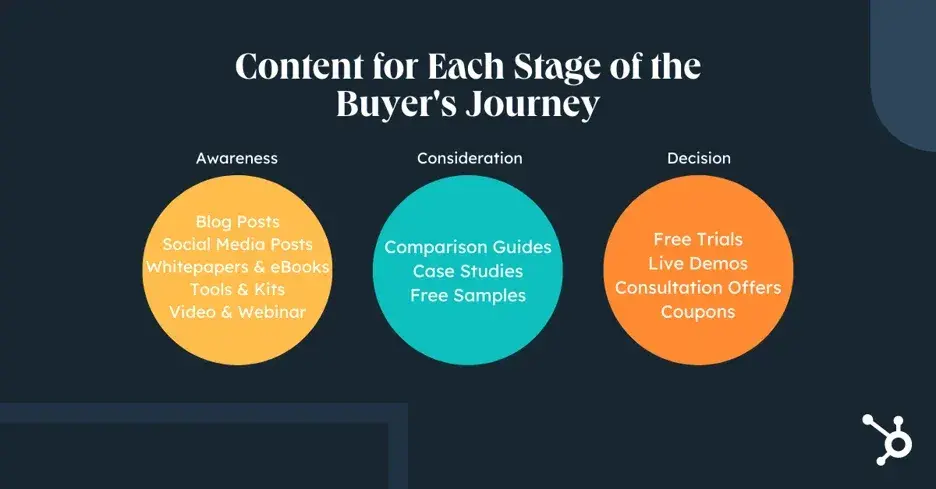
So, let’s take it from the top and start from the beginning of the buyer’s journey.
At the awareness stage, a buyer is looking for top-level educational content to help direct them to a solution, like blog posts, social content, and ebooks.
Their value as a lead is low because there’s no guarantee that they’ll buy from you. But those who find your content helpful and interesting may journey on to the middle of the funnel.
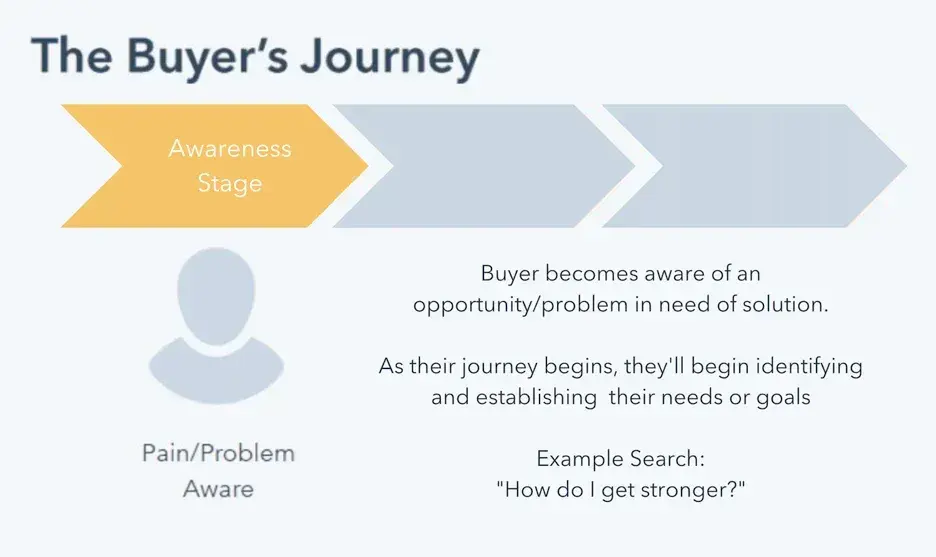
The ideal channels for the awareness stage may include:
- Blogging
- Search Engine Marketing
- Social Media Marketing
Let’s run through the different content formats best suited for these channels.
Content Formats for the Awareness Stage
- Blog Post
- Social Media Post
- Whitepaper
- Checklist
- How-To Video
- Kit or Tool
- Ebook or Tip Sheet
- Educational Webinar
1. Blog Post
A blog post is an ideal piece of content targeting the awareness stage.
By targeting a pain, problem, or topic your target audience wants to discover and then posting it to your website, you’re creating a brand asset that’s crawlable by Google and discoverable by search engine users.
You can also promote your blog content across other channels.
When I’m having trouble ideating topics that align with my audience’s pain points, HubSpot’s Blog Ideas Generator can come in handy — just type in a few details about your audience or content, and the platform will generate catchy titles relevant to your input.
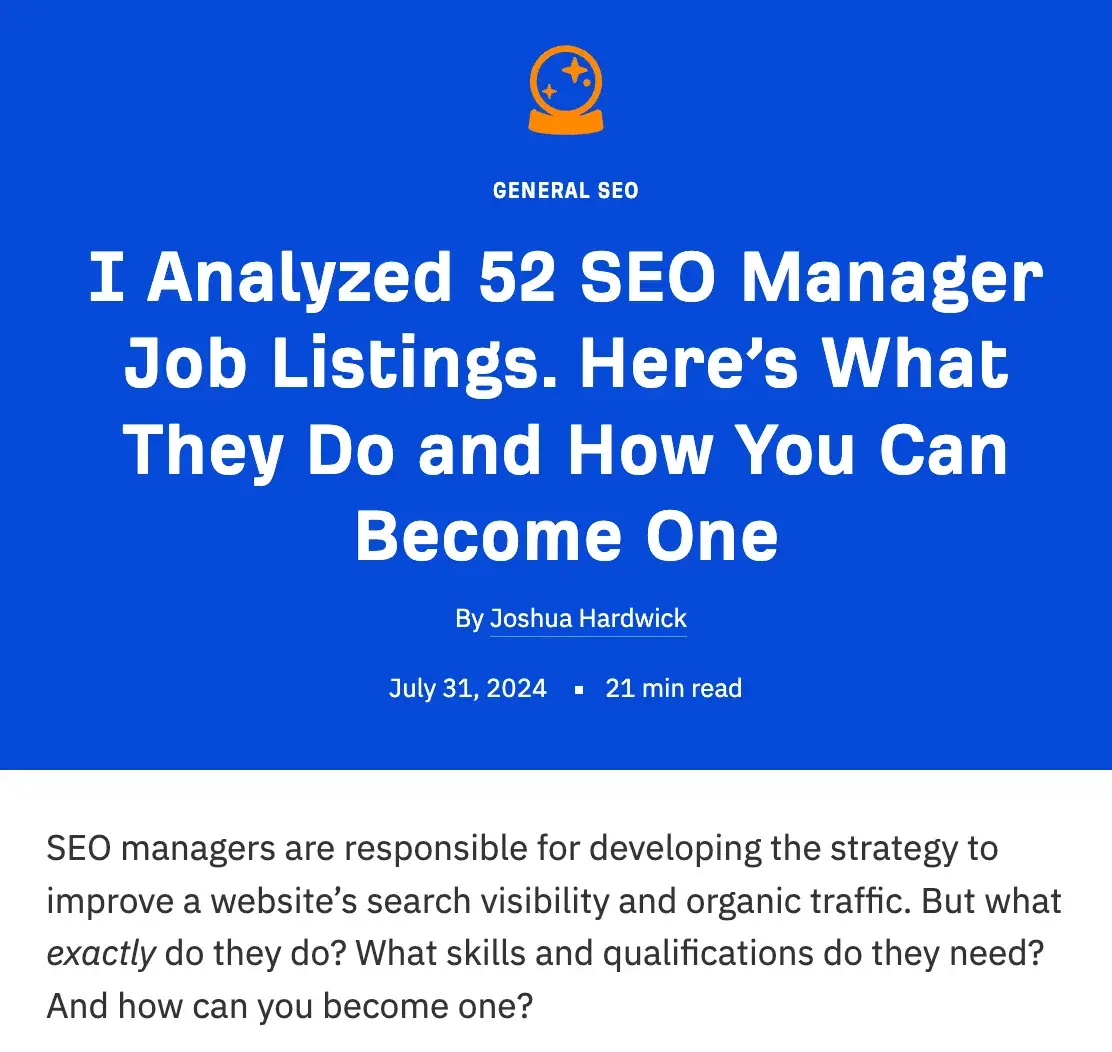
Ahrefs does blog content right. They include original data and informational advice to create long-form articles that serve their audience.
Featured Resource: 6 Free Blog Post Templates
2. Social Media Post
You can use social media to promote your other content, and you can also create content specifically for the channel.
According to Backlinko, 86.1% of all eligible audiences aged 18+ are active on social media. Since I target B2B SaaS companies, my social channel of choice is LinkedIn.
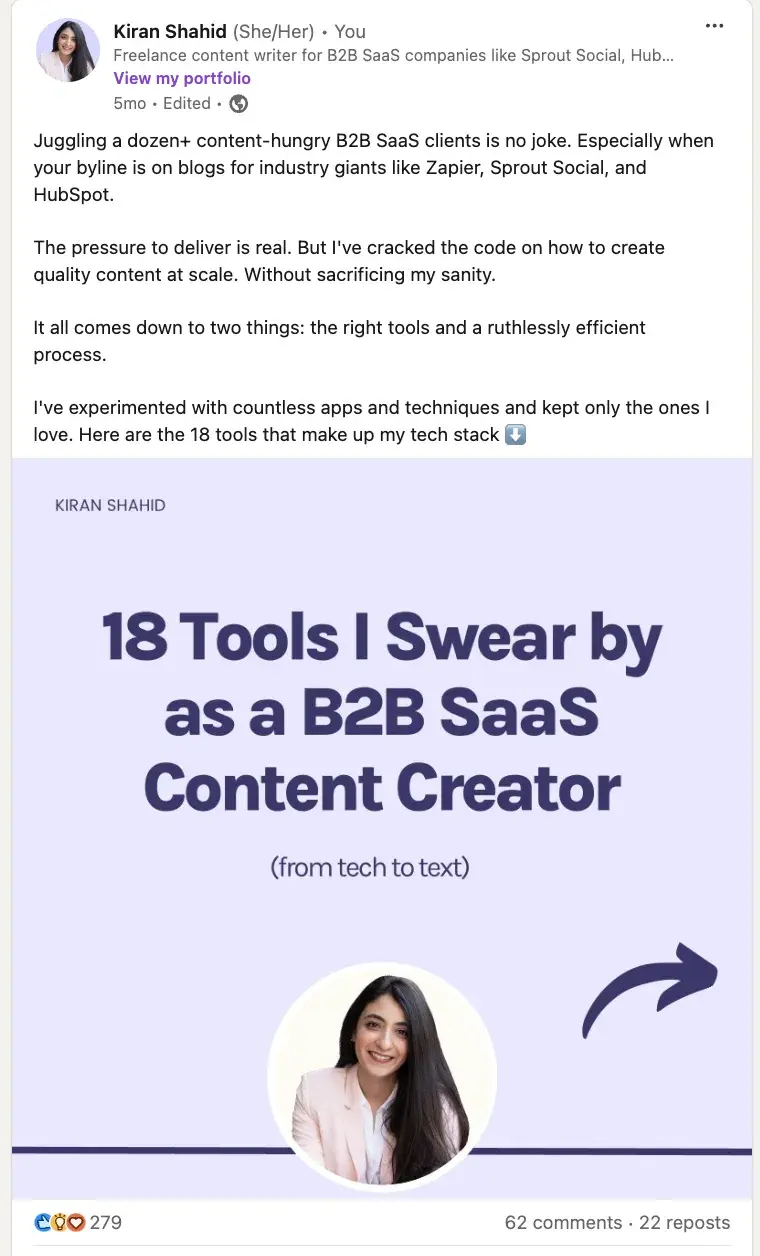
In the above example, I’ve shared a carousel on my top tools on LinkedIn. These formats are popular on LinkedIn, as the content is created to be snackable with short-form take-aways.
3. Whitepaper
A whitepaper is an organization’s report or guide on a particular topic.
Whitepapers are especially useful as downloadable offers when readers want to go more in-depth on a specific subject they’re reading about.
I‘ve found it’s crucial to provide unique information your audience can‘t find elsewhere, which helps audiences understand the report’s value and compels them to download it.
Every year, HubSpot publishes a survey on the state of marketing to provide helpful guidance based on thought leadership to marketers, sales professionals, and business owners.
Inside, readers find statistics from a broad survey and industry experts’ opinions on what the data means and where the industry is going.
4. Checklist
For complicated tasks with many moving parts, your audience may simply want a blueprint that spells out what they’re supposed to do to achieve their end goal.

Buying a home is a perfect example of this, and Opendoor meets its audience’s needs by providing a handy checklist (in infographic form!) for the reader that spells out all the steps that need to be taken. The graphic is aesthetically pleasing and even allows room for a few tips along the way.
5. How-To Video
My experience has taught me that sometimes, the best way to solve a pain or problem is to learn a new skill.
While a purchase may be required along the way, your audience often needs to become more informed about the problem and potential solutions first. That‘s where I’ve seen instructional video content really shine.
HubSpot Marketing has a series of videos dedicated to teaching viewers about where SEO principles are broken down to the audience in easy-to-understand language and visuals. Knowing that SEO is a complex subject, the Marketing team aims to make it accessible to viewers.

Content Marketing Planning Templates
Plan your content strategically with these handy templates.
- Editorial Calendar Template
- Buyer Persona Templates
- SWOT Analysis Templates
- SMART Goal Template
Download Free
All fields are required.

6. Kit or Tool
I‘ve learned that informational content for a broad audience isn’t always sufficient for my buyer personas to make a decision.
In some cases, they require more utility or personalization. That‘s why I’ve found kits and tools to be excellent content pieces for guiding readers along their path to purchase.
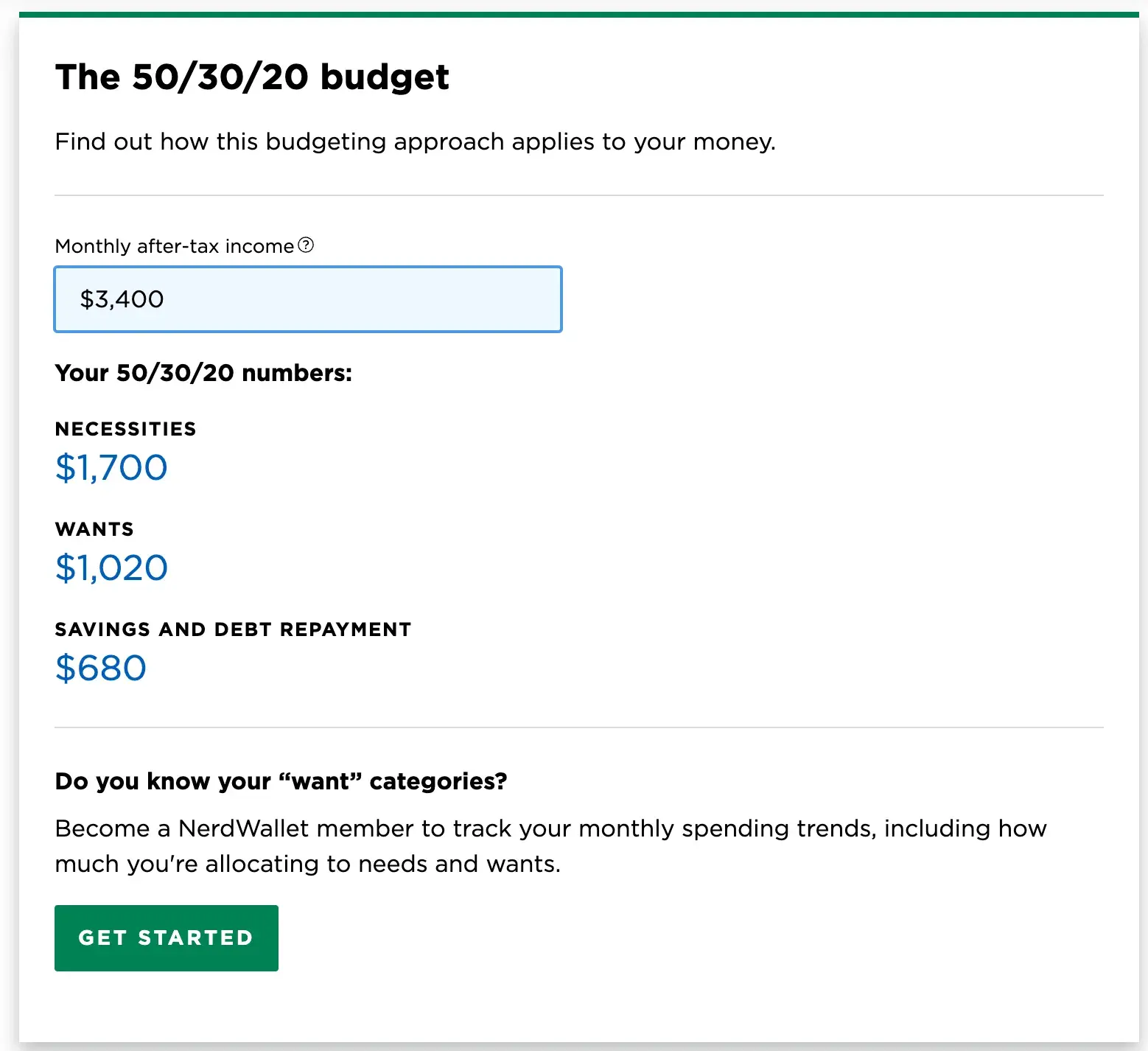
Nerdwallet creates content around several financial topics, budgeting being one of them. It can be challenging to create a budget, though, so they developed a calculator that allows users to provide their own numbers to receive customized recommendations.
7. Ebook or Tip Sheet
Similar to whitepapers, I've had success using ebooks and tip sheets as downloadable content. However, I typically make these shorter and more actionable.

CoSchedule combines a few tactics by promoting their headline analyzer tool with a blog post about writing great headlines that drive traffic.
On that blog post, they include a great tip sheet of powerful words to include in headlines if you want to catch a reader’s attention.
Featured Resource: 36 Free Ebook Templates
8. Educational Webinar
A webinar is a web seminar where information is typically provided through video.
A webinar can be prerecorded or streamed live, which opens up many possibilities for disseminating information to an audience that wants more visual and auditory content.
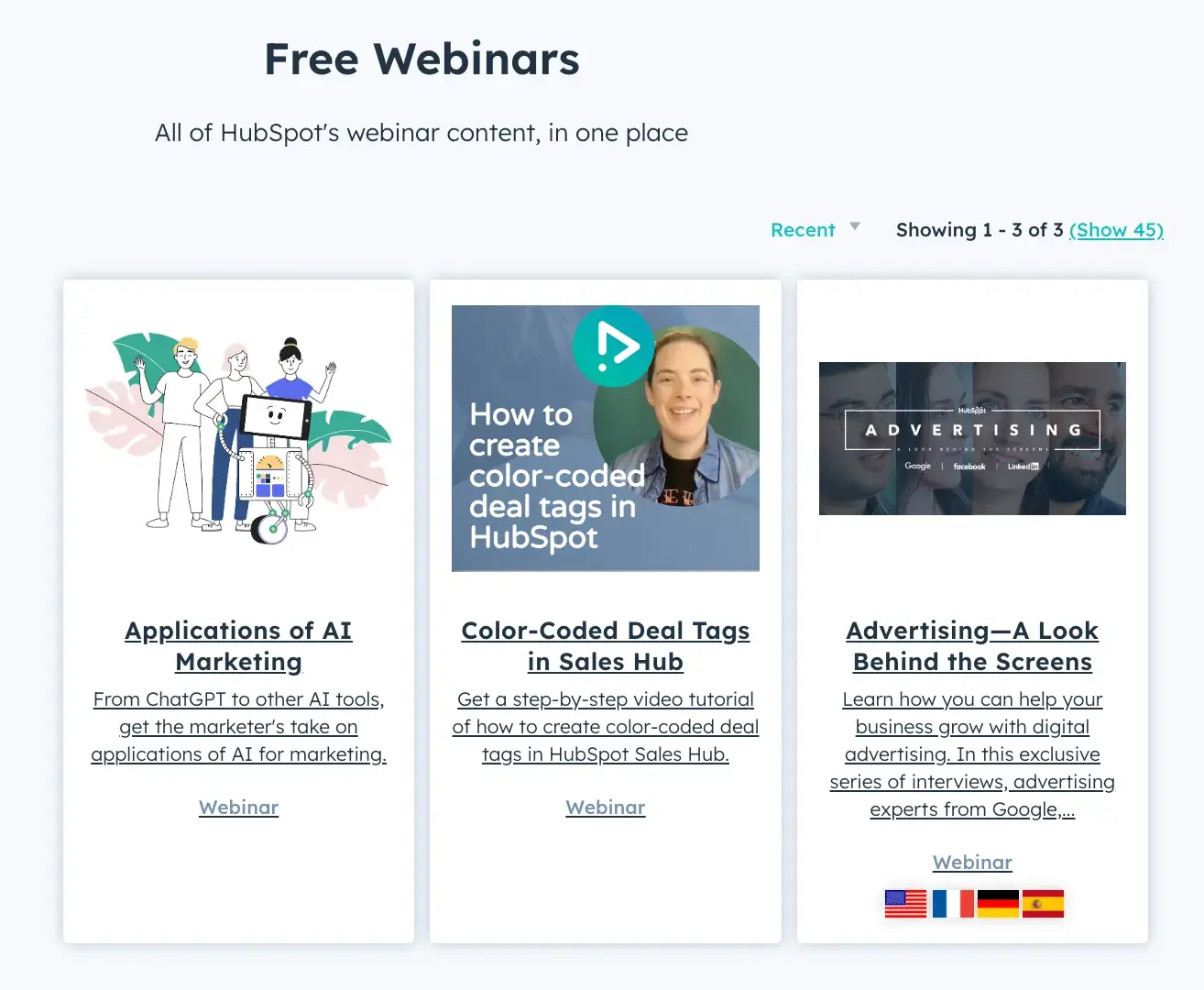
At HubSpot, we create webinars as a key part of our content marketing strategy and often run a valuable topic multiple times to get more mileage out of the content.
Moving on from the awareness stage content, let’s delve into the next stage of the buyer’s journey.
When someone moves into the consideration stage, it means you’ve captured their attention. They know they have a problem that has to be solved, and now they’re trying to discover the best solution. The need for a future purchase commitment creeps up as they’re evaluating their options.
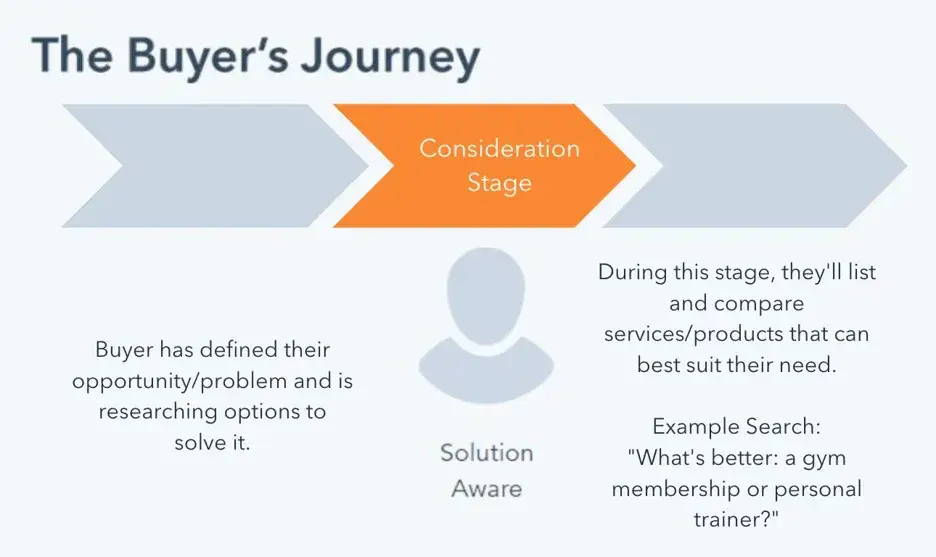
This stage is typically a point of extended engagement where you’re nurturing a lead, building a relationship, and establishing trust between the audience and your brand.
The ideal channels for your consideration stage may include:
- Website or Blogging
- Search Engine Marketing
- Email Marketing
- Social Media
Let’s go through the best content formats for this part of the buyer’s journey.
Content Formats for the Consideration Stage
- Product Comparison Guide
- Case Study
- Free Sample
1. Product Comparison Guides
In the consideration stage, the buyer persona still considers solutions to their pain or problem. For this reason, product comparisons are a great way to help them decide.
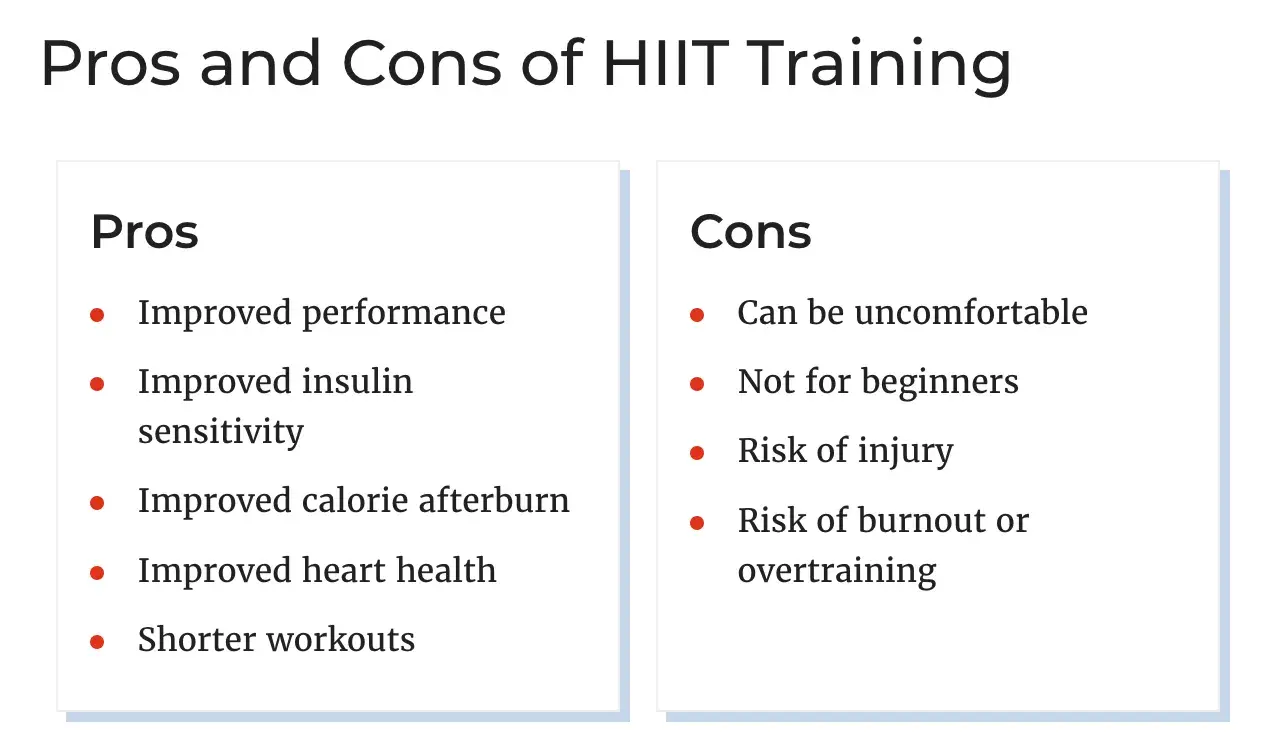
For example, when I worked with a project management SaaS, we created comparison guides between different competitor tools to help our readers understand which tool might work best for their team.
2. Case Study
I've successfully used case studies in both the consideration and decision stages. In my view, a well-crafted case study convinces the reader that our solution works by showcasing real results for actual clients.
When I create case studies for my B2B SaaS clients, I make sure to appeal to both emotions and logic. I tell a compelling story about the client's challenges while providing detailed, quantitative data on how our solution solved their problems.
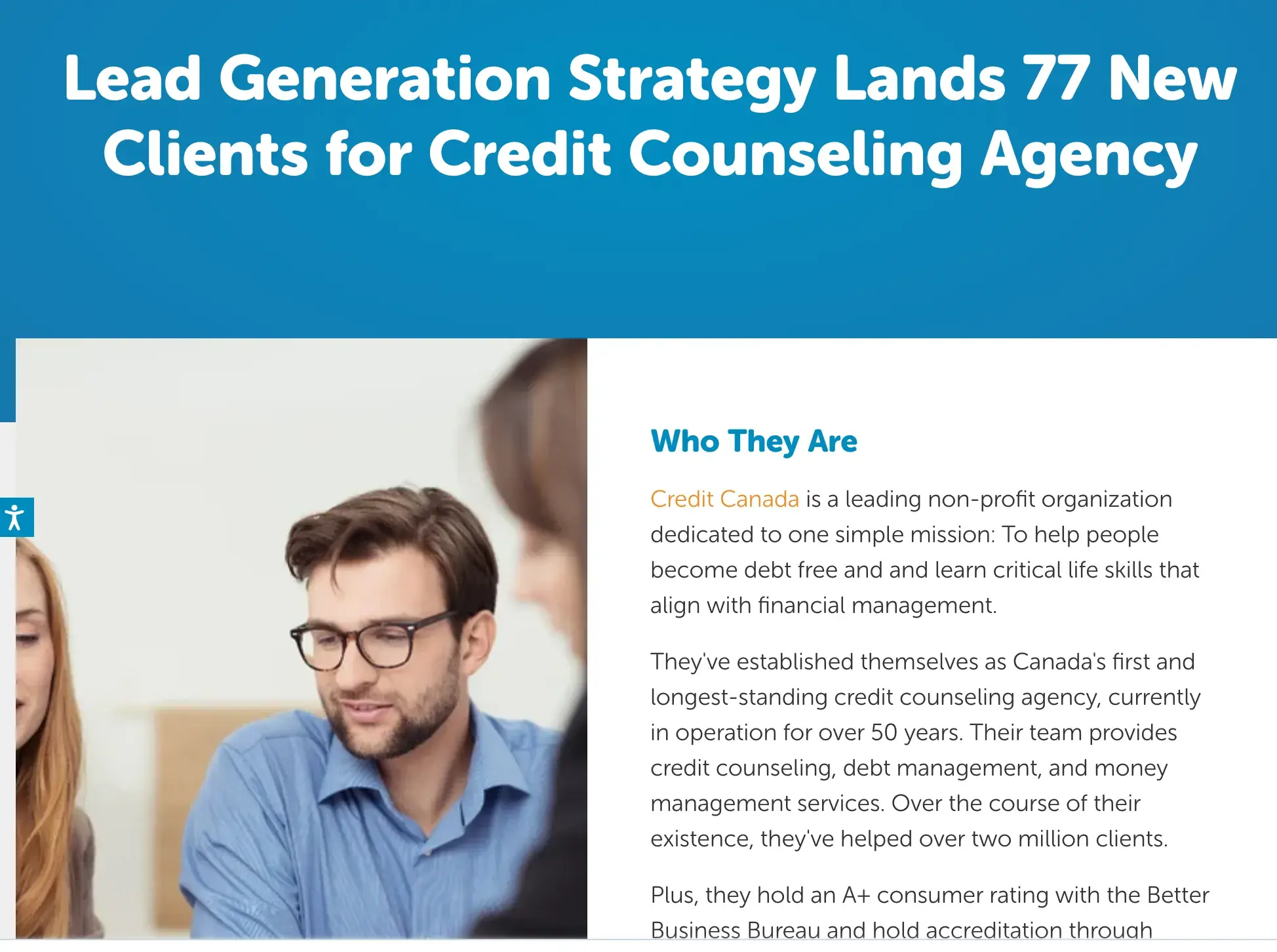
HubSpot Partner Agency Blueleadz tells a story about their client and their problems while providing a detailed account of how they solved them.
Featured Resource: 3 Free Case Study Templates
3. Free Sample
A free sample is another example of content or an offer that overlaps between the buyer’s journey stages. Consider this: An individual wants to paint the inside of their home but doesn’t know what color.
As they consider which color (the solution) to use, they pick up paint chip cards from their hardware store. A provider creates these cards based on their individual solution. When the individual falls in love with a color, they already know who the provider is that makes it.
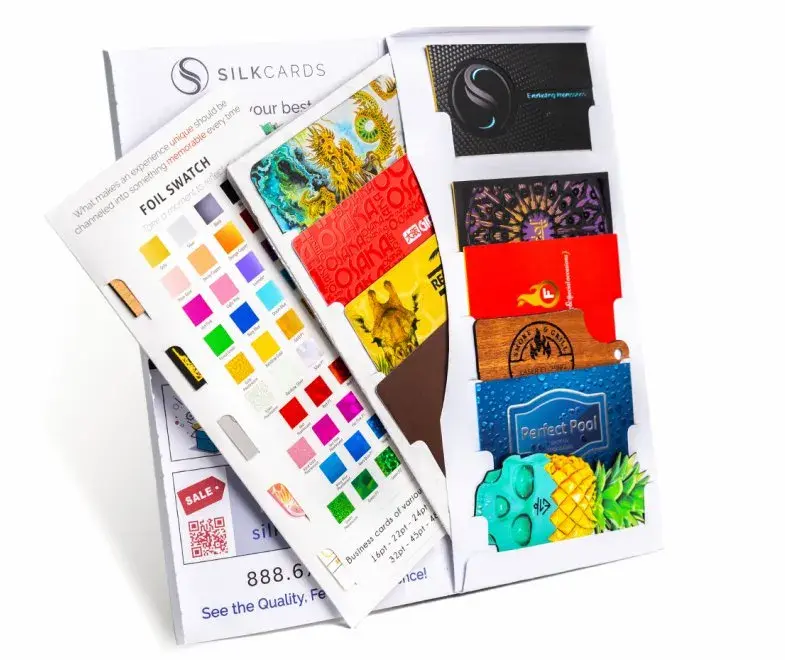
SILKCARDS taps into this buying behavior by offering samples of their unique printing methods on the content that they create.
They know their business is tactile, and digital content alone is not enough to close a deal. Once their prospective customer holds the sample in their hands, other business cards are put to shame.
So, now that you’ve provided content to help customers list out or sample their options, it’s time to move them into the decision stage.
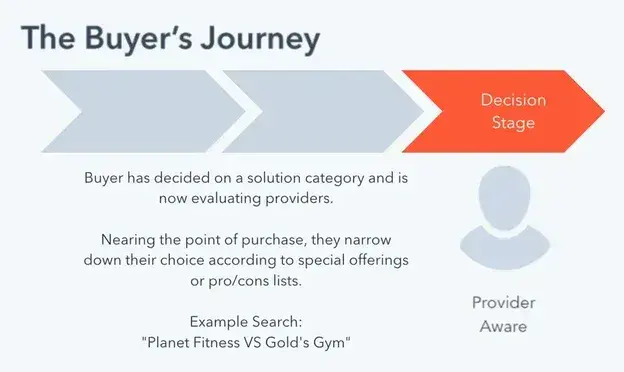
As prospects near the end of the buyer’s journey, they’re evaluating providers down to specific or specialized offerings.
Marketers, in turn, want to go above and beyond their expectations and provide an easy and frictionless customer experience that can win them over their competitors.
Handling objections, remove hesitation, position ahead of comp
In my experience, the most effective channels for decision-stage content include:
- Website.
- Email marketing.
- Live chat and chatbots for service.
Here are the content formats I've found most effective in helping prospects get closer to purchase.
Content Formats for the Decision Stage
- Free Trial or Live Demo
- Consultation Offer
- Coupon
1. Free Trial or Live Demo
Most of my clients in B2B SaaS offer free trials of their products. Free trials allow potential customers to experience the power of the tools firsthand. Once they see how new tools impact productivity and efficiency, they’re much more likely to become paying customers.
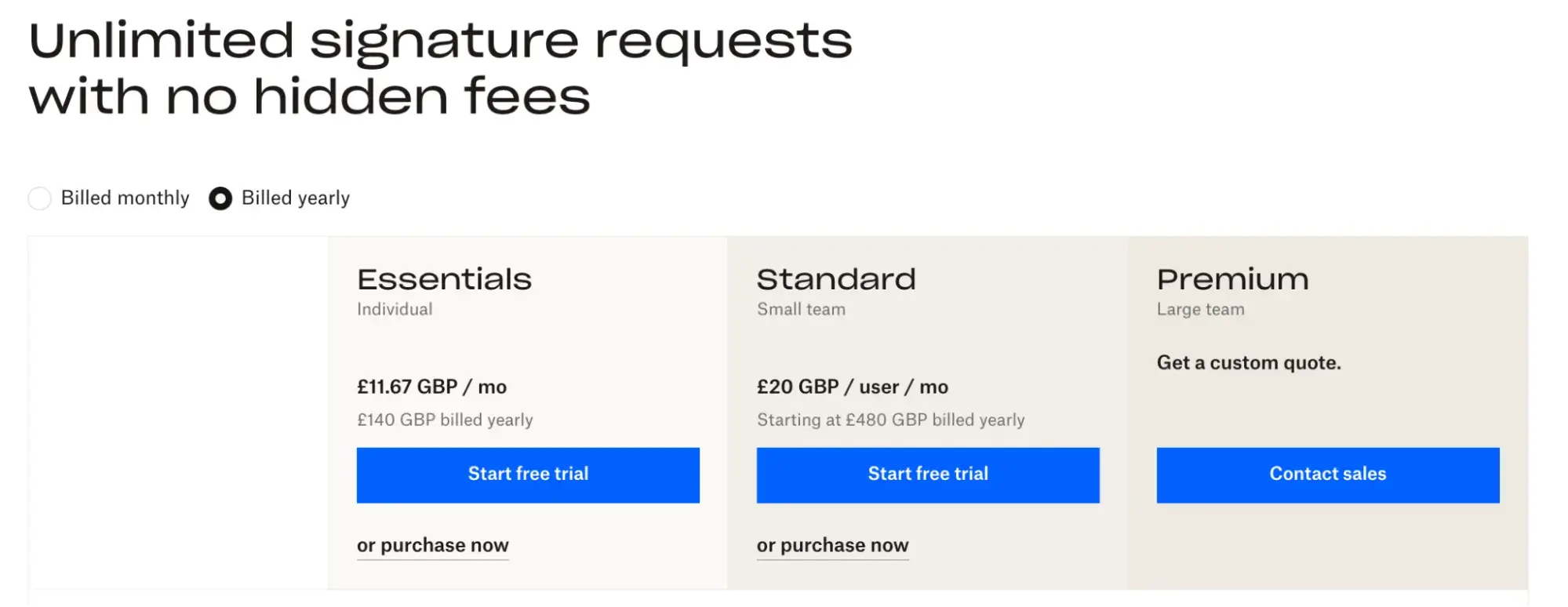
Dropbox Sign does this well. Though they have a free option with limitations, they know that offering a free trial upfront is the key to getting clients into their larger tiers. Their pricing page sets the prospect’s expectations and points them to the free trial.
2. Consultation Offer
A consultation is another example of providing just a little bit of service in exchange for the opportunity to close the sale.
The best consultation reduces the anxiety of entering into a sales conversation by promising something concrete they can walk away with (a strategy or actionable advice) in exchange for their time.
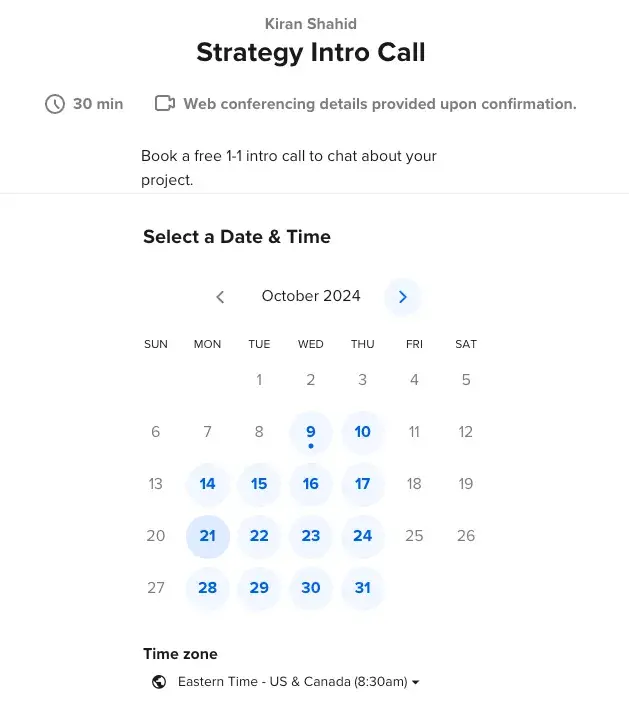
In my B2B SaaS strategies, I often include consultation offers. I've found they work best when they promise concrete, actionable advice.
To increase conversions, I always make scheduling as frictionless as possible and use automated booking systems like Calendly.
3. Coupon
A coupon appeals to a fear of missing out (FOMO) mindset.
By reducing the price by a certain amount, a coupon is handing a price objection while convincing the prospect that they’re leaving money on the table if they don’t use the coupon. This inertia is enough to win the prospect’s business.
While traditional coupons aren‘t as common in B2B SaaS, I’ve had success with limited-time offers or special pricing for early adopters. This creates a sense of urgency and can be the final push a prospect needs to make a decision.

Fragrant Jewels does this well by gamifying its coupons.
By spinning the wheel, the website visitors have the chance to get a coupon before checking out the products. They’ll likely evaluate the products that are a good deal with the coupon they won.
Beyond the decision stage, I always emphasize the importance of creating content to satisfy existing customers. In my experience, this often includes comprehensive knowledge bases, regular feature update announcements, and advanced tips and tricks to help users get the most out of the software.
Mapping Content Across All Stages of the Buying Cycle
In my years of experience as a content strategist, I’ve learned that every business has a unique buyer’s journey — one that demands a tailored approach for optimal results. I can't simply replicate a strategy from one client to another.
And that starts by getting to know your audience and understanding their needs, pain points, and decision-making process. Once you have that understanding, you develop a strategy that maps custom content — whether it’s educational blog posts or product demos — to each phase of their journey.
When a content strategy truly matches a buyer's journey, it improves customer relationships while boosting conversions and loyalty.
Editor's note: This post was originally published in August 2016 and has been updated for comprehensiveness.

Content Marketing Planning Templates
Plan your content strategically with these handy templates.
- Editorial Calendar Template
- Buyer Persona Templates
- SWOT Analysis Templates
- SMART Goal Template
Download Free
All fields are required.







